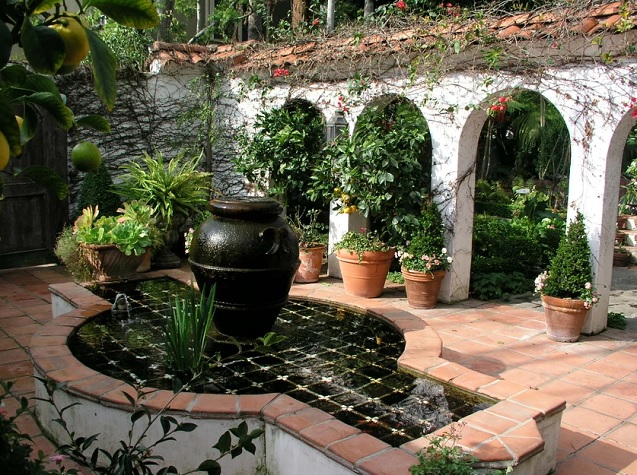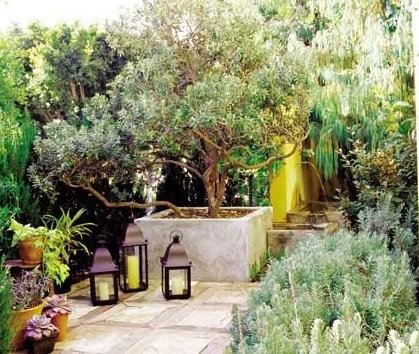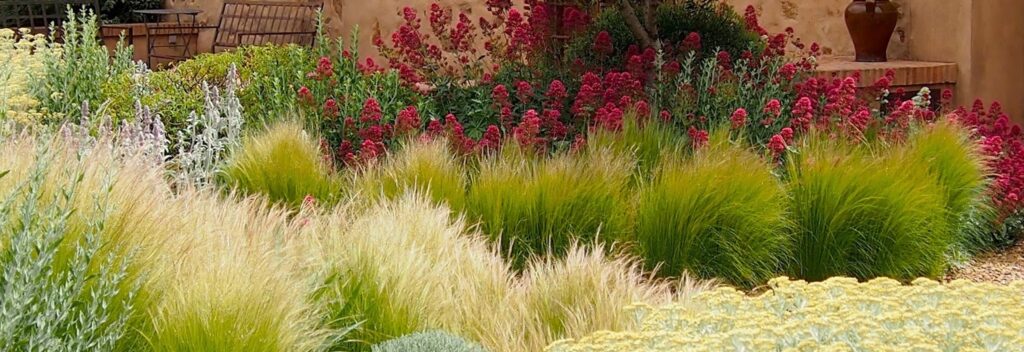
How to Create a Mediterranean Garden: Plant and Design Inspiration
Create a Mediterranean garden with low-maintenance, drought-tolerant plants for a relaxing design that evokes memories of sun-drenched vacations.
Recreating the feeling of a Mediterranean garden is easier than you imagine. Furthermore, with predictions of continued hot and dry summers, making our gardens more drought resistant is increasingly important.
A Mediterranean garden overflows with architectural, aromatic and low-maintenance plants; Gravel and paving replace time-consuming lawns, and seating areas and potted plants abound, so incorporate some or all of these elements into your Mediterranean garden ideas to recreate the feeling of sunnier climes.
MEDITERRANEAN GARDEN PLANTS TO INCLUDE
Evoking the feeling of a Mediterranean garden involves experimenting with a variety of different plants.
You don’t have to live in Italy or Spain to incorporate herbs, shrubs and flowers from those countries into your flower bed ideas; You can recreate the feeling in a sheltered spot on a border or on the patio.



Many drought-tolerant Mediterranean plants are what you will have on a list when planning a dry garden. In late winter, in a Mediterranean garden, you will often see acacias and citrus trees in all their glory; In spring, crocuses, ornamental grasses, annuals and rockroses take center stage, and in summer it is bougainvilleas, pelargoniums, herbs, oleanders and olive trees that we are most familiar with. Then in autumn there is a small burst of beauty with cyclamen and autumn crocuses, with rosemary often blooming year-round and architectural palms adding height and Riviera glamour.
Classic plant options for a Mediterranean garden include:
- olives
- citrus plants
- Agave
- Agapanthus
- Lavender
- Romero
- Herbs
- pelargoniums
- buganvilla
- palms
- Cypress
- Yucas
HOW TO PLANT IN A MEDITERRANEAN GARDEN
Spring is an ideal time to plant a Mediterranean garden, when the soil has warmed a little, and to prevent roots from rotting after wet and cold winters.
Select the right plant for the right location, considering both soil and appearance. The more you can mimic a plant’s native growing conditions, the more likely it is to thrive with little maintenance.
“Mediterranean plants have evolved to enjoy long, sunny days, where excellent quality of light is key, so avoid planting in the shade of large trees.
Peter offers the following planting tips:
- Mediterranean garden plants prefer free-draining soil, so don’t plant them in a site that is flooded in winter.
- Consider how frost settles in your garden
- A south-facing site that enjoys sun all day, protected from the elements, is ideal
- Mediterranean plants generally prefer nutrient-poor soil, so avoid feeding the soil.
- Prune and trim rosemary, lavender, and rockrose after flowering to prevent them from becoming woody and leggy.
Many drought tolerant plants will form plant communities and the key to this style is to repeat planting a few options, rather than a lot of variety.
MEDITERRANEAN GARDEN DESIGN IDEAS
A sunny slope is ideal for creating a Mediterranean style garden, as drought-tolerant plants prefer free-draining soil, but any sunny area will work well, with a gravel mulch to keep the crowns dry and provide a suitable background. .
Consider evoking romantic, windswept sand dunes by weaving a wooden boardwalk through your Mediterranean garden. Take inspiration from rock garden ideas and edge with rugged rocks and gravel to reflect the coastline. Plant herbs and ornamental shrubs that imitate wild shrubs found in arid areas.
Make the most of dry soil conditions by planting a combination of Stipa gigantea (golden oats), Santolina chamaecyparissus (cotton lavender), nepeta (catnip), sage and small hebes.

LANDSCAPING OF A MEDITERRANEAN GARDEN
Warm-toned gravel and paving are typical of the Mediterranean garden style, with terraces created for alfresco dining and pergolas added for shade, on which climbing plants are trained.
For a small garden idea , this is a practical option, dispensing with high-maintenance grasses and instead using gravel or paving as a base for the design, softened with ground cover and a variety of containers.
Create relaxed and informal spaces, surrounded by textures, aromatic plants and rustic details. It takes some planning to create this weathered atmosphere, with the structure and planting working together.
Terrace levels with stone walls, natural stone paving and whitewashed walls are also common, or inject some color and pattern with mosaic details on walls, risers or patios.
To prevent plants from self-seeding in a gravel garden, lay landscape fabric over the soil and cut crosses to insert the plants, then add a layer of gravel in between. Choose a color of gravel to complement the other hardscaping elements and materials in the garden.
USE OF POT IN A MEDITERRANEAN GARDEN
Terracotta pots filled with bright, vibrant flowers, citrus trees or architectural palms or yucca plants are the hallmark of a Mediterranean garden.
Include containers of various sizes, smaller pots to line walls and display in groups, and large, oversized containers to draw attention as part of your patio ideas.
Make sure all containers have good drainage and fill the bottom of the pots with crocodiles or stones before adding the compost to facilitate drainage.
Place the pots in a sunny, sheltered area of the garden, and water only when the compost feels dry. Tender plants can be moved indoors for the winter if you live in colder climates.
WHAT IS A MEDITERRANEAN GARDEN STYLE?
The Mediterranean garden style refers to the garden characteristics of the countries surrounding the Mediterranean Sea, such as Spain, France, Greece and Italy . Some plants grown in the Mediterranean are genuinely native to the Mediterranean, while others are from similar climates in California, South Africa or South America , but all are adapted to the Mediterranean climate.
In the wild Mediterranean, plants enjoy wet, relatively mild winters followed by dry, sunny summers. Many grow during the winter, flower in the spring, set seed, and then take a break.
In a Mediterranean garden, most plants enjoy sunlight and good drainage and, although they need winter moisture, they hate winter moisture. Many, especially bulbs, appreciate dry, even parched, summer soil.
WHAT PLANTS GROW IN A MEDITERRANEAN GARDEN?
There are many options for plants growing in a Mediterranean garden. Many of the plants you see in these summer hot spots will grow very well anywhere if given a sunny, sheltered location and well-draining soil.

And as climate change begins to have an impact on gardens, more and more areas already have similar growing conditions (low rainfall, summer sun and dry winters) to those of the Mediterranean, making plants native to This area is ideal for a plot without hoses. .
Simple terracotta pots, the classic choice for Mediterranean garden containers, planted with colorful pelargoniums and fresh-leaved succulents will recreate the spirit of a Greek balcony.
Or you could transform a sun seating area into an Italian-inspired terrace, surrounding it with herbs such as oregano, thyme and bay leaf. Add a pergola, then plant scented climbers or grow a vine – the leafy canopy will also provide welcome dappled shade.
HOW DO I MAKE MY GARDEN MEDITERRANEAN?
Creating a Mediterranean garden is easier than you think. If you have room to spare and a temperate location with free-draining soil, you could easily replicate the style.
Use a tree, such as an olive or hardy palm, as a focal point, then add shrubs and perennials, such as Portuguese laurel, euphorbias, and genista. Plant fragrant flowers such as jasmine and lavender – as their perfumes are released, they will evoke happy memories of getaways in the sun.
Mediterranean winters tend to be cold and dry, so native plants can be surprisingly hardy. But when prolonged cold combines with humidity, they will suffer. If your soil is not naturally free-draining, be sure to dig in plenty of sand; Alternatively, consider building some raised beds to improve drainage.
Growing these plants in containers is another option, especially if you have heavy clay soil or live somewhere with a lot of rainfall. Pots also have the advantage that they can be easily moved indoors in autumn.
Whether you simply want to add a touch of the Mediterranean or embrace your planting wholeheartedly, Mediterranean garden ideas are surprisingly easy to create.



